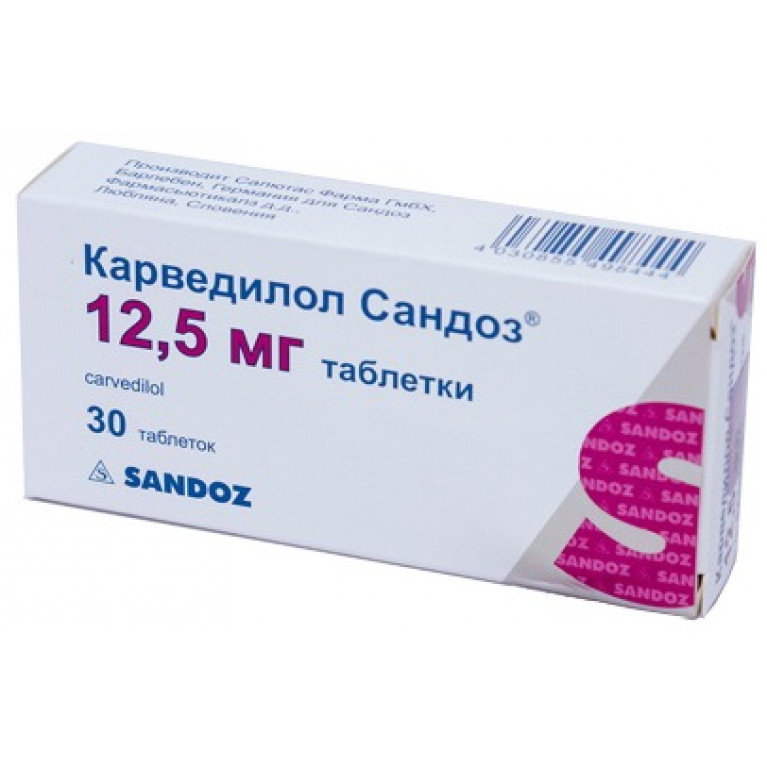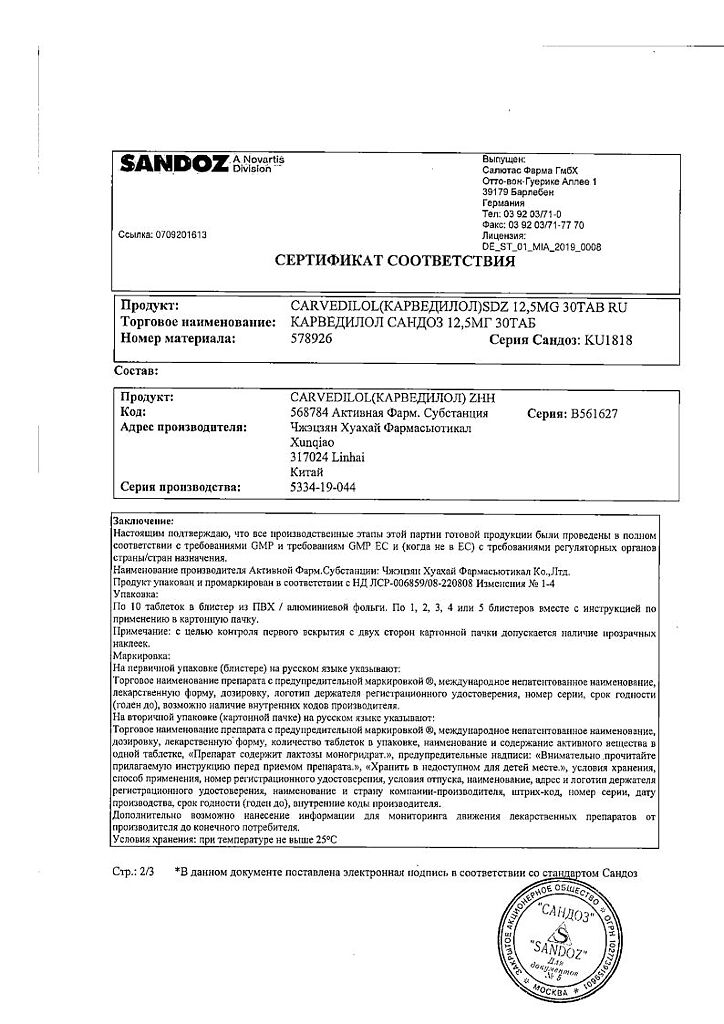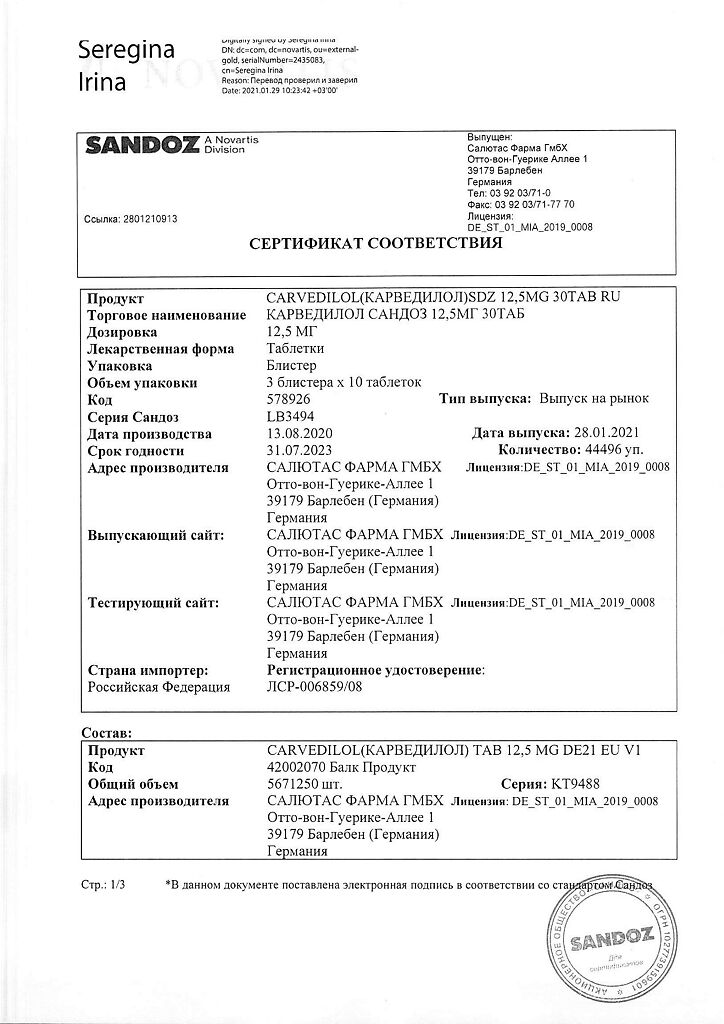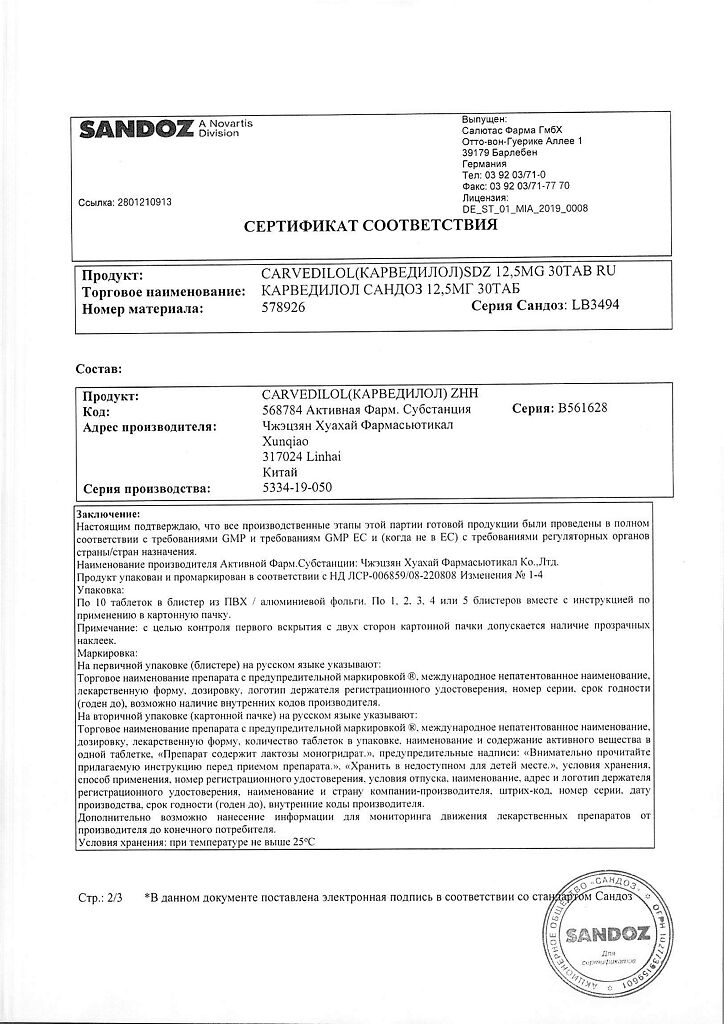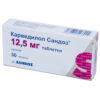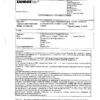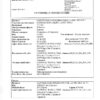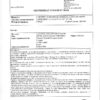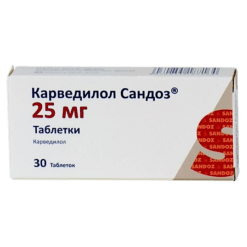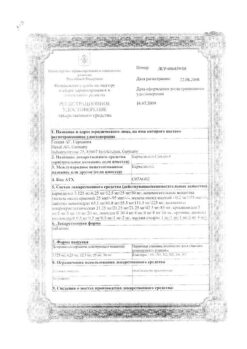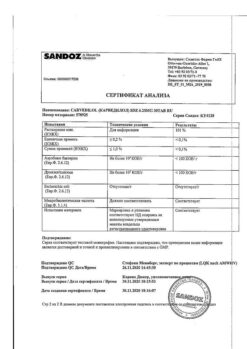No products in the cart.
Carvedilol Sandoz, tablets 12.5mg 30 pcs
€7.04 €6.16
Description
Pharmacodynamics
Carvedilol blocks alpha-1-, beta-1- and beta-2-adrenoreceptors. It has vasodilatory, antianginal and antiarrhythmic effects. Vasodilatory effect is mainly related to blockade of alpha 1-receptors.
Because of vasodilatation it reduces total peripheral vascular resistance (TPR). It has no sympathomimetic activity of its own and has membrane stabilizing properties. The combination of vasodilation and beta-adrenoreceptor blockade leads to the following effects: in patients with arterial hypertension, the decrease in arterial pressure (BP) is not accompanied by an increase in OPPS, peripheral blood flow is not reduced (unlike beta-adrenoblockers). HR decreases insignificantly.
In patients with CHD it has antianginal action. It decreases pre- and post-loading on the heart. It has no expressed effect on lipid metabolism and the content of potassium, sodium and magnesium in the blood plasma. In patients with left ventricular dysfunction or circulatory insufficiency, it has a favorable effect on hemodynamic parameters and improves the ejection fraction and left ventricular size. It has an antioxidant effect by eliminating free oxygen radicals.
Pharmacokinetics
Carvedilol is rapidly and almost completely absorbed after oral administration from the gastrointestinal tract. It is almost completely bound to blood plasma proteins (98-99%). The plasma concentration is proportional to the dose taken. Bioavailability is about 25% due to high metabolism in the liver. Metabolites with high ability to block beta-adrenoreceptors are formed.
The maximum concentration in plasma is reached after 1 hour. Half-life period is 6-10 hours.
In elderly patients, the plasma concentration of carvedilol is approximately 50% higher than in younger patients. It is excreted mainly with bile. In patients with impaired liver function the bioavailability may increase to 80%. It penetrates through the placental barrier and is excreted with breast milk. Food slows absorption of the drug, but does not affect its bioavailability.
Indications
Indications
Active ingredient
Active ingredient
Composition
Composition
1 tablet contains:
the active ingredient:
carvedilol 12.5 mg,
excipients:
iron oxide;
lactose monohydrate;
MCC;
povidone;
povidone K30;
silicon dioxide colloid;
magnesium stearate.
How to take, the dosage
How to take, the dosage
Orally, regardless of meals.
Strictly follow the instructions of your physician. You should not stop the treatment with Carvedilol or change its dosage without first consulting your doctor. If it is necessary to cancel the drug, the dose should be reduced gradually over a period of 1 to 2 weeks.
If there is no therapeutic effect of treatment or a worsening of your condition is noted, consult your doctor.
Arterial hypertension.
The dose is adjusted individually. For the first 7-14 days, the recommended dose of Carvedilol is 12.5 mg (1 tablet of 12.5 mg) taken in the morning after breakfast. The dose may be divided into two doses of 6, 25 mg of Carvedilol (1/2 tablet of 12.5 mg). Further treatment should be carried out with Carvedilol in a dose of 25 mg (1 tablet of 25 mg) in the morning or divided into two doses of 12.5 mg of the drug (1 tablet of 12.5 mg). If necessary, after 14 days, the doctor may increase the dose again.
Take the drug after meals with a small amount of liquid.
Stable angina pectoris. The initial dose of Carvedilol is 12.5 mg (1 tablet of 12.5 mg) twice a day. After 7-14 days, under medical control, the dose of Carvedilol can be increased to 25 mg (1 tablet of 25 mg) twice a day. After 14 days, in case of insufficient effectiveness and good tolerability, the dose of Carvedilol can be further increased.
The total daily dose of Carvedilol for angina should not exceed 50 mg of the drug (2 tablets of 25 mg) administered twice a day. If your age exceeds 70 years, the daily dose of Carvedilol should not exceed 25 mg (1 tablet of 25 mg) twice a day.
If you have missed your next dose, you should take the drug as soon as possible.
However, if the time for the next dose is approaching, you should take only that dose, without doubling it.
You must take the medication regularly. If you have not taken the drug for more than 2 weeks, you should resume treatment with the lowest dose.
Chronic heart failure. The dose is adjusted individually, under the close supervision of a physician. The recommended starting dose is 3.125 mg 2 times a day for 2 weeks. If tolerated well, the dose is increased at intervals of at least 2 weeks to 6.25 mg 2 times a day, then to l2.5 mg 2 times a day, then to 25 mg 2 times a day. The dose should be increased to the maximum that is well tolerated by the patient. In patients with body weight less than 85 kg the target dose is 50 mg per day; in patients with body weight over 85 kg the target dose is 75-100 mg per day.
If treatment is interrupted for more than 2 weeks, treatment is restarted with a dose of 3.125 mg twice daily, with subsequent dose increases.
Interaction
Interaction
Carvedilol may potentiate the effect of other simultaneously taken antihypertensive agents or drugs that have a hypotensive effect (nitrates).
In concomitant use of Carvedilol and diltiazem, cardiac conduction abnormalities and hemodynamic disorders may develop.
The concomitant use of carvedilol and digoxin increases the concentration of the latter and may increase atrioventricular conduction time.
Carvedilol may potentiate the effects of insulin and oral hypoglycemic agents, and the symptoms of hypoglycemia (especially tachycardia) may mask, therefore regular monitoring of blood sugar levels is recommended in diabetic patients.
Microsomal oxidation inhibitors (cimetidine) enhance and inducers (phenobarbital, rifampicin) weaken the hypotensive effect of carvedilol.
Drugs that reduce catecholamines (reserpine, monoamine oxidase inhibitors) increase the risk of arterial hypotension and marked bradycardia.
Concomitant use of cyclosporine increases the concentration of the latter (correction of the daily dose of cyclosporine is recommended).
The concomitant administration of clonidine may potentiate the antihypertensive and cardiac rhythm-relieving effects of carvedilol.
General anesthetics increase the negative inotropic and hypotensive effects of carvedilol.
Special Instructions
Special Instructions
The therapy should be prolonged and should not be stopped abruptly, especially in patients with coronary heart disease, as this may worsen the course of the underlying disease. If necessary, reduction of the drug dose should be gradual, over 1-2 weeks.
At the beginning of therapy with carvedilol or when increasing the drug dose, patients, especially elderly patients, may have an excessive decrease in blood pressure, predominantly when standing up. Correction of the drug dose is necessary. Patients with chronic heart failure may experience an increase in symptoms of heart failure and edema when adjusting the dose. In this case the dose of carvedilol should not be increased, it is recommended to prescribe high doses of diuretics until the patient’s condition stabilizes.
Continuous monitoring of electrocardiogram and blood pressure is recommended with simultaneous administration of carvedilol and slow calcium channel blockers, phenylalkylamine derivatives (verapamil) and benzodiazepine (diltiazem), and also with class I antiarrhythmic agents.
It is recommended to monitor renal function in patients with chronic renal failure, arterial hypotension and chronic heart failure.
If surgery is performed using general anesthesia, the anesthesiologist should be advised of prior therapy with Carvedilol.
Carvedilol does not affect blood glucose concentration and does not cause changes in glucose tolerance test in patients with insulin-independent diabetes mellitus.
At the time of treatment avoid the use of ethanol.
Patients with pheochromocytoma should be prescribed alpha-adrenoblockers before starting therapy.
Patients who wear contact lenses should be aware that the drug may cause decreased tear production.
It is not recommended to drive at the beginning of therapy and when increasing the dose of carvedilol. Other activities requiring high concentration and rapid psychomotor reactions should be refrained from.
Contraindications
Contraindications
With caution
Bronchospastic syndrome, chronic bronchitis, pulmonary emphysema, Prinz-metal angina, thyrotoxicosis, peripheral vascular occlusive disease, pheochromocytoma, psoriasis, renal failure, grade I atrioventricular block, extensive surgery and general anesthesia, diabetes, hypoglycemia, depression, myasthenia.
Side effects
Side effects
Central nervous system: headache, dizziness, syncopal states, muscle weakness (more often at the beginning of treatment), sleep disturbance, depression, paresthesias.
Cardiovascular system disorders: bradycardia, orthostatic hypotension, angina pectoris, atrioventricular blockade, rare “intermittent” claudication, peripheral circulation disorders, progression of heart failure.
Gastro-intestinal tract: dry mouth, nausea, abdominal pain, diarrhea or constipation, vomiting, increased “liver” transaminase activity.
Hematopoietic disorders: thrombocytopenia, leukopenia.
Urinary system disorders: severe renal dysfunction, edema.
Allergic reactions: skin allergic reactions (exanthema, urticaria, itching, rash), exacerbation of psoriatic rash, sneezing, nasal congestion, bronchospasm, shortness of breath (in predisposed patients).
Others: flu-like syndrome, pain in the extremities, decreased lacrimation, increased body weight.
Overdose
Overdose
Symptoms: decreased blood pressure (accompanied by dizziness or fainting), bradycardia. Dyspnea due to bronchospasm and vomiting may occur. In severe cases, cardiogenic shock, respiratory distress, confusion, conduction disorders are possible.
Treatment: monitoring and correction of vital signs should be carried out, if necessary – in the intensive care unit. Treatment is symptomatic. Intravenous use of m-cholinoblockers (atropine), adrenomimetics (epinephrine, norepinephrine) is advisable.
Pregnancy use
Pregnancy use
There have been no controlled studies of Carvedilol use in pregnant women; therefore, the drug may be administered to this category of patients only when the benefit to the mother exceeds the potential risk to the fetus.
Breastfeeding during treatment with Carvedilol is not recommended.
Similarities
Similarities
Additional information
| Shelf life | 3 years. |
|---|---|
| Conditions of storage | Store in a dry place, protected from light, at a temperature not exceeding 25 ° C. |
| Manufacturer | Salutas Pharma GmbH, Germany |
| Medication form | pills |
| Brand | Salutas Pharma GmbH |
Other forms…
Related products
Buy Carvedilol Sandoz, tablets 12.5mg 30 pcs with delivery to USA, UK, Europe and over 120 other countries.

